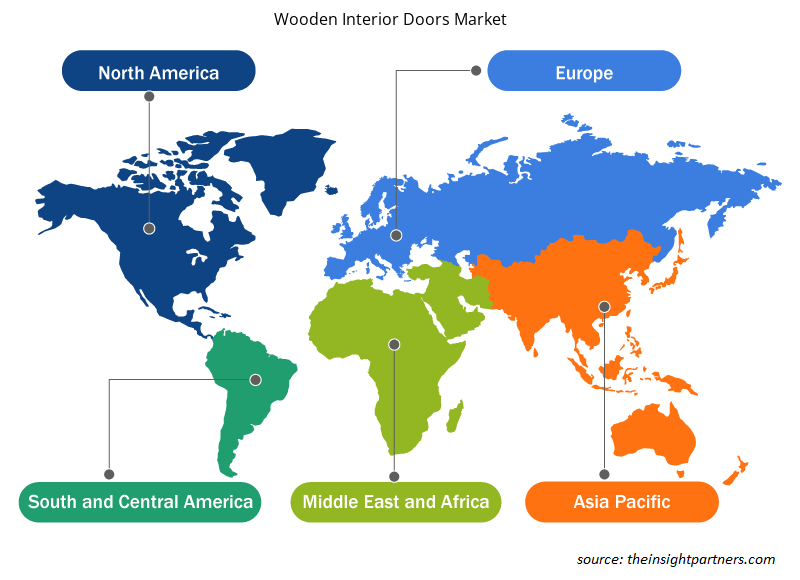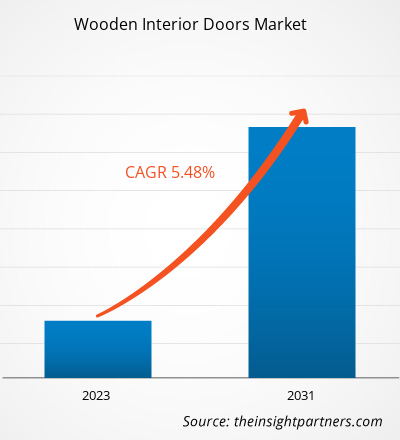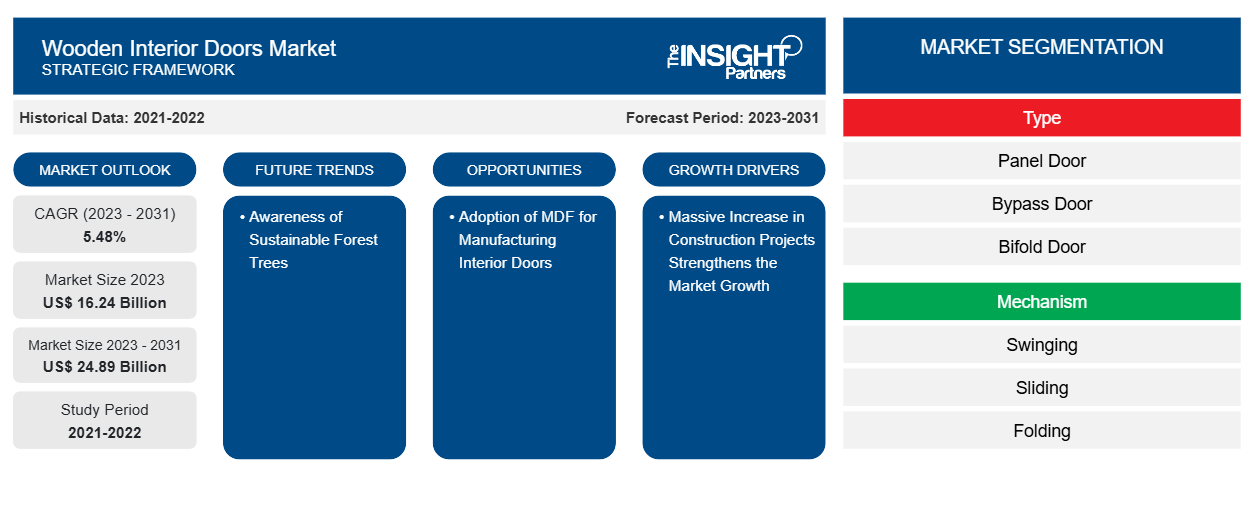Der Markt für Innentüren aus Holz soll von 16,24 Milliarden US-Dollar im Jahr 2023 auf 24,89 Milliarden US-Dollar im Jahr 2031 anwachsen. Der Markt soll in den Jahren 2023–2031 eine durchschnittliche jährliche Wachstumsrate (CAGR) von 5,48 % verzeichnen. Laut Global Construction 2030 wird das Volumen der Bauproduktion weltweit bis 2030 voraussichtlich um 85 % auf 15,5 Billionen US-Dollar steigen. Die USA, China und Indien werden voraussichtlich die Vorreiterrolle übernehmen und mehr als die Hälfte des gesamten globalen Wachstums ausmachen. Darüber hinaus steigern Investitionen in die Renovierung alter Gebäude und Strukturen sowie eine zunehmende Tendenz zu einer grüneren Zukunft den Umfang grüner Gebäude, was den Bausektor weiter fördert.
Marktanalyse für Innentüren aus Holz
Im Zeitalter der zunehmenden Urbanisierung floriert der Bausektor enorm. Mit der Zunahme der Bauprojekte boomt auch die Nachfrage nach entsprechenden Komponenten, darunter Einrichtungsprodukte wie Innentüren. Um mit dem Tempo der zunehmenden Urbanisierung Schritt zu halten, ohne die Umwelt zu schädigen, wird daher nachhaltige Forstwirtschaft betrieben. Bei der nachhaltigen Forstwirtschaft steht die Erhaltung natürlicher Wälder durch Aufforstung und Wiederaufforstung sowie die Verwendung umweltschonender Abholzungstechniken im Mittelpunkt.
Marktübersicht für Innentüren aus Holz
Schätzungen zufolge wird der Wohnungsbau anhalten, und daher ist es unerlässlich, eine geeignete Lösung zu finden, um den Bedarf der urbanisierten Bevölkerung zu decken. Prognosen zufolge werden bis 2030 3 Milliarden Menschen (fast 40 % der Weltbevölkerung) neuen Wohnraum benötigen, was einem Bedarf von etwa 300 Millionen neuen Wohnungen entspricht. Der oben erwähnte wachsende Bedarf an Wohnraum, gepaart mit dem Bedürfnis nach einer sicheren Umgebung, treibt also das Konzept der nachhaltigen Forstwirtschaft voran . Dieser Aspekt wird sich positiv auf das Wachstum des Marktes für Innentüren aus Holz auswirken.
Passen Sie diesen Bericht Ihren Anforderungen an
Sie erhalten kostenlos individuelle Anpassungen an jedem Bericht, einschließlich Teilen dieses Berichts oder einer Analyse auf Länderebene, eines Excel-Datenpakets sowie tolle Angebote und Rabatte für Start-ups und Universitäten.
-
Holen Sie sich die wichtigsten Markttrends aus diesem Bericht.Dieses KOSTENLOSE Beispiel umfasst eine Datenanalyse von Markttrends bis hin zu Schätzungen und Prognosen.
Markttreiber und Chancen für Innentüren aus Holz
Massiver Anstieg der Bauprojekte stärkt das Marktwachstum
Mit der wachsenden städtischen Bevölkerung ist der Bedarf an Hochhäusern in städtischen Gebieten erheblich gestiegen. Laut dem Council on Tall Buildings and Urban Habitat (CTBUH) wurden in den letzten zwei Jahrzehnten in den USA 1.480 Wolkenkratzer mit einer Höhe von über 200 m gebaut. Darin sind auch 40 Wohnwolkenkratzer enthalten, die in den letzten Jahren gebaut wurden. Der Anstieg der Bauarbeiten im Wohn- und Gewerbebau sowie in mehreren Branchen aufgrund der zunehmenden Urbanisierung treibt das Wachstum bei Innentüren voran. Regierungsstellen legen zusätzlichen Wert auf die Stärkung des Bauwesens und der Infrastrukturentwicklung, was die Nachfrage nach Innentüren weiter ankurbelt.
Einsatz von MDF zur Herstellung von Innentüren
MDF ist ein Holzwerkstoff, der in der Regel aus recycelten Holzfasern hergestellt wird. Aufgrund seiner Haltbarkeit und Erschwinglichkeit wird MDF zum am häufigsten verwendeten Material für Innentüren. Darüber hinaus sind MDF-Innentüren dichter als Sperrholz und Spanplatten, was ein weiterer Faktor ist, der sowohl für den privaten als auch für den gewerblichen Bereich attraktiv ist. Abgesehen von den oben genannten Merkmalen unterscheidet sich MDF von Spanplatten und anderen Holzmaterialien durch seine extrem glatten Kanten und die Tatsache, dass keine Laminate erforderlich sind. Daher ist die Beliebtheit von MDF im Aufwärtstrend, was Herstellern von Innentüren aus Holz lukrative Geschäftsmöglichkeiten bieten dürfte.
Marktbericht zu Innentüren aus Holz – Segmentierungsanalyse
Wichtige Segmente, die zur Ableitung der Marktanalyse für Innentüren aus Holz beigetragen haben, sind Typ, Mechanismus und Endbenutzer.
- Basierend auf der Methode ist der Markt in Paneeltüren, Bypasstüren , Falttüren, Schiebetüren und andere unterteilt. Das Segment Paneeltüren hatte im Jahr 2023 einen größeren Marktanteil.
- Basierend auf dem Mechanismus ist der globale Markt für Innentüren aus Holz in Schwing-, Schiebe-, Falttüren und andere unterteilt. Das Schwingsegment hatte im Jahr 2023 einen größeren Marktanteil.
- Je nach Endverbraucher ist der globale Markt in Wohn- und Nichtwohngebäude unterteilt. Das Wohnsegment hatte im Jahr 2023 einen größeren Marktanteil.
Marktanteilsanalyse für Innentüren aus Holz nach geografischen Gesichtspunkten
Der Umfang des Marktberichts für Holzinnentüren umfasst Nordamerika (USA, Kanada und Mexiko), Europa (Spanien, Großbritannien, Deutschland, Frankreich, Italien und den Rest Europas), den asiatisch-pazifischen Raum (Südkorea, China, Indien, Japan, Australien und den Rest des asiatisch-pazifischen Raums), den Nahen Osten und Afrika (Südafrika, Saudi-Arabien, die Vereinigten Arabischen Emirate und den Rest des Nahen Ostens und Afrikas) sowie Süd- und Mittelamerika (Brasilien, Argentinien und den Rest Süd- und Mittelamerikas). In Bezug auf den Umsatz dominierte der asiatisch-pazifische Raum im Jahr 2023 den Marktanteil für Holzinnentüren. Europa ist der zweitgrößte Beitragszahler zum globalen Markt für Holzinnentüren, gefolgt von Nordamerika. In der globalen Marktlandschaft gehörte China im Jahr 2022 zu den größten MDF-Verbrauchern und hielt mehr als 50 % des gesamten Marktvolumens. Darüber hinaus überholte China die USA beim MDF-Verbrauch. Weißrussland, die Türkei und Polen sind weitere bedeutende Märkte, die für den höchsten MDF-Verbrauch pro Kopf bekannt sind. Ein derart hoher Verbrauchstrend in diesen Ländern dürfte den Einsatz von MDF bei der Herstellung von Einrichtungsgegenständen , einschließlich Innentüren, vorantreiben .
Regionale Einblicke in den Markt für Holzinnentüren
Die regionalen Trends und Faktoren, die den Markt für Innentüren aus Holz im gesamten Prognosezeitraum beeinflussen, wurden von den Analysten von Insight Partners ausführlich erläutert. In diesem Abschnitt werden auch die Marktsegmente und die Geografie von Innentüren aus Holz in Nordamerika, Europa, im asiatisch-pazifischen Raum, im Nahen Osten und Afrika sowie in Süd- und Mittelamerika erörtert.

- Erhalten Sie regionale Daten zum Markt für Innentüren aus Holz
Umfang des Marktberichts zu Innentüren aus Holz
| Berichtsattribut | Details |
|---|---|
| Marktgröße im Jahr 2023 | 16,24 Milliarden US-Dollar |
| Marktgröße bis 2031 | 24,89 Milliarden US-Dollar |
| Globale CAGR (2023 - 2031) | 5,48 % |
| Historische Daten | 2021-2022 |
| Prognosezeitraum | 2023–2031 |
| Abgedeckte Segmente |
Nach Typ
|
| Abgedeckte Regionen und Länder |
Nordamerika
|
| Marktführer und wichtige Unternehmensprofile |
|
Marktteilnehmerdichte für Innentüren aus Holz: Auswirkungen auf die Geschäftsdynamik verstehen
Der Markt für Innentüren aus Holz wächst rasant. Dies wird durch die steigende Nachfrage der Endverbraucher aufgrund von Faktoren wie sich entwickelnden Verbraucherpräferenzen, technologischen Fortschritten und einem größeren Bewusstsein für die Vorteile des Produkts vorangetrieben. Mit der steigenden Nachfrage erweitern Unternehmen ihr Angebot, entwickeln Innovationen, um die Bedürfnisse der Verbraucher zu erfüllen, und nutzen neue Trends, was das Marktwachstum weiter ankurbelt.
Die Marktteilnehmerdichte bezieht sich auf die Verteilung der Firmen oder Unternehmen, die in einem bestimmten Markt oder einer bestimmten Branche tätig sind. Sie gibt an, wie viele Wettbewerber (Marktteilnehmer) in einem bestimmten Marktraum im Verhältnis zu seiner Größe oder seinem gesamten Marktwert präsent sind.
Die wichtigsten auf dem Markt für Innentüren aus Holz tätigen Unternehmen sind:
- Konzept SGA Inc
- Simpson Door Co
- Jeld-Wen Holding Inc
- Marvin Ltd
- Masonite International Corp
- Holzgrain Inc.
Haftungsausschluss : Die oben aufgeführten Unternehmen sind nicht in einer bestimmten Reihenfolge aufgeführt.

- Überblick über die wichtigsten Akteure auf dem Markt für Holzinnentüren
Marktnachrichten und aktuelle Entwicklungen für Innentüren aus Holz
Der Markt für Innentüren aus Holz wird durch die Erhebung qualitativer und quantitativer Daten nach Primär- und Sekundärforschung bewertet, die wichtige Unternehmensveröffentlichungen, Verbandsdaten und Datenbanken umfasst. Im Folgenden finden Sie eine Liste der Entwicklungen auf dem Markt für Innentüren aus Holz und der Strategien:
- Im Februar 2022 hat Simpson Redi-Prime, eine der bekanntesten Marken für außergewöhnlich gefertigte, lackierte Innentüren , seine Produktlinie um Clipped Corner Doors für einzigartige Räume in einem Haus erweitert. Da viele weiterhin Renovierungen vornehmen, um den sich ständig weiterentwickelnden Funktionen eines Hauses gerecht zu werden, wird die obere Ecke einer Redi-Prime Clipped Corner Door für eine individuelle Passform bereits schräg zugeschnitten geliefert. Das Ergebnis ist eine speziell angefertigte Designlösung für jede Anwendung, für die eine standardmäßige Innentür mit quadratischer Oberseite nicht geeignet ist. (Quelle: Simpson Door Company, Pressemitteilung/Unternehmenswebsite/Newsletter)
Marktbericht zu Innentüren aus Holz – Abdeckung und Ergebnisse
Der Bericht „Marktgröße und Prognose für Innentüren aus Holz (2021–2031)“ bietet eine detaillierte Analyse des Marktes, die die folgenden Bereiche abdeckt:
- Marktgröße und Prognose auf globaler, regionaler und Länderebene für alle wichtigen Marktsegmente, die im Rahmen des Projekts abgedeckt sind
- Marktdynamik wie Treiber, Beschränkungen und wichtige Chancen
- Wichtige Zukunftstrends
- Detaillierte Porter's Five Forces Analyse
- Globale und regionale Marktanalyse mit wichtigen Markttrends, wichtigen Akteuren, Vorschriften und aktuellen Marktentwicklungen
- Branchenlandschaft und Wettbewerbsanalyse, einschließlich Marktkonzentration, Heatmap-Analyse, prominenten Akteuren und aktuellen Entwicklungen
- Detaillierte Firmenprofile mit SWOT-Analyse
- Historische Analyse (2 Jahre), Basisjahr, Prognose (7 Jahre) mit CAGR
- PEST- und SWOT-Analyse
- Marktgröße Wert/Volumen – Global, Regional, Land
- Branchen- und Wettbewerbslandschaft
- Excel-Datensatz
Aktuelle Berichte
Verwandte Berichte
Erfahrungsberichte
Grund zum Kauf
- Fundierte Entscheidungsfindung
- Marktdynamik verstehen
- Wettbewerbsanalyse
- Kundeneinblicke
- Marktprognosen
- Risikominimierung
- Strategische Planung
- Investitionsbegründung
- Identifizierung neuer Märkte
- Verbesserung von Marketingstrategien
- Steigerung der Betriebseffizienz
- Anpassung an regulatorische Trends























 Kostenlose Probe anfordern für - Markt für Innentüren aus Holz
Kostenlose Probe anfordern für - Markt für Innentüren aus Holz